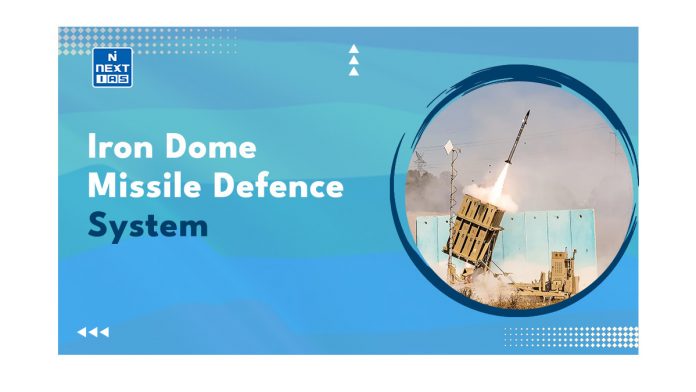The Iron Dome is a missile defence system developed by Israel to protect against short-range rockets and artillery shells.
Iron Dome System
It was first deployed in 2011. It has played a significant role in protecting Israeli cities and military bases from rocket attacks. The State of Israel is vulnerable to air attacks particularly those launched by Hamas from the Gaza Strip and Hezbollah from Lebanon.
The recent attacks by Hamas is one such example.
Need of Iron Dome
The development of the Iron Dome was motivated by the frequent rocket attacks that Israel faced, particularly from Gaza. It has since been integrated into Israel’s broader air defence strategy, which includes other systems like the David’s Sling and the Arrow missile defence systems.
Details of Iron Dome
| Country of origin | Israel |
| Entered service | 2011 |
| Number of missiles | 20 |
| Missile length | 3 m |
| Missile diameter | 0.16 m |
| Missile weight | 90 kg |
| Warhead type | Fragmentation |
| Range of fire | 4 – 70 km |
Working of Iron Dome
The system operates by using advanced radar to detect incoming rockets and then launches interceptor missiles to destroy them in mid-air. This helps to prevent the rockets from reaching their intended targets on the ground.
This missile defence system consists of three main components that work together to provide protection over the area where it is deployed. These components are:
- Detection and Tracking Radar: This radar system is responsible for detecting and tracking incoming threats, such as rockets and artillery shells. It plays a critical role in identifying the trajectory, speed, and location of the incoming projectiles.
- Battle Management and Control (BMC) System: The BMC system is the command and control center that processes the information from the radar and makes real-time decisions regarding whether an intercept is necessary. It calculates the projected impact point of the incoming threat and determines whether it poses a danger to populated areas.
- Missile Firing Unit: When the BMC system decides that an intercept is necessary, the missile firing unit launches an interceptor missile to intercept and destroy the incoming threat. These interceptor missiles are known as Tamir and are equipped with advanced guidance systems to accurately home in on the target and neutralize it in mid-air.
Effectiveness of Iron Dome
- According to Israeli officials, the missile system boasts an estimated effectiveness rate ranging from 75% to 95%. It is widely acclaimed for its superior efficiency, particularly when compared to earlier missile defence systems like the U.S. Patriot.
- Presently, it stands as one of the most rigorously tested missile defence systems globally. It has successfully intercepted hundreds of missiles and artillery rockets launched by Palestinian militants.
- By 2015, it had recorded approximately 1,500 successful interceptions. Thanks to its reliability, failures of the Iron Dome have resulted in minimal Israeli casualties.
Significance
The Iron Dome missile defence system holds significant importance for Israel and the broader region for several reasons:
- Protection of Civilian Populations: Its primary purpose is to protect Israeli cities and communities from rocket attacks, including those launched by Hamas in Gaza and Hezbollah in Lebanon.
- Enhanced National Security: It enhances Israel’s national security by reducing the threat of rocket attacks.
- Strategic Deterrence: It serves as a deterrent against potential adversaries and dissuades hostile actors from initiating rocket attacks.
- International Cooperation: The successful deployment and export of the Iron Dome have strengthened Israel’s diplomatic ties with other countries, particularly the United States.
- Innovation and Technological Advancement: The development and continued improvement of the Iron Dome represent a significant achievement in missile defence technology.
Limitations
The effectiveness of Iron Dome is under question amid the Israel-Hamas conflict. The Israel Defence Forces (IDF) reported that approximately 2,200 rockets were launched toward southern and central Israel which might have overwhelmed the system that it couldn’t prevent the missiles in the populated areas. Some of the limitations are as follows:
- Cost: The system is expensive to develop, deploy, and maintain.
- Limited Range: It is primarily designed to intercept short-range rockets and artillery shells. It is not effective against longer-range ballistic missiles.
- Limited Interception Window: It has a limited window for interception, and it may not be effective against very short-range rockets that are fired from close proximity.
- Multiple Simultaneous Threats: When facing a large barrage of incoming rockets or artillery shells, the Iron Dome may struggle to intercept all of them simultaneously. It may prioritize targets based on their trajectory and threat level, leaving some threats unaddressed.
Way Forward
The ongoing effectiveness of the Iron Dome in the face of evolving adversary tactics and the extensive breach of a heavily fortified perimeter wall on October 7, which went undetected, will undoubtedly be subject to in-depth analysis and scrutiny in the foreseeable future.
Sources:









